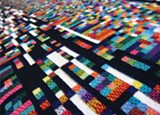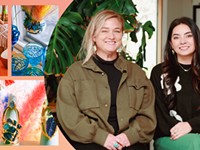[
{
"name": "500x250 Ad",
"insertPoint": "5",
"component": "15667920",
"parentWrapperClass": "",
"requiredCountToDisplay": "1"
}
]
Rochester Contemporary's current show, "signals_now_," was created in collaboration with Signal Culture, a new experimental media studio soon to be located in Owego, New York, run by artists Debora and Jason Bernagozzi. The exhibit showcases four artists who will be among the first to participate in Signal Culture's residency program, and who each question the place of media in our lives, and the ways we engage with it.
Signal Culture aims to encourage the creation of new work and the building of community in the field of experimental media art, and intends to offer real-time analog and digital image processing equipment and resources, both vintage and contemporary. This spot will cater to a contingent of people in the video-art world who use media-editing tools as artist's tools, and who seek greater control over media editing, says Rochester Contemporary Executive Director Bleu Cease.
Within this niche group are artists such as Peer Bode, of Hornell, New York, a professor of video arts at the School of Art and Design at Alfred University who creates works that focus on the physical manipulation of media. Bode is represented in this show by heavily manipulated video art and prints of video stills.
Bode is committed to more engagement, more self-consciousness about the tools he is using, says Cease. The artist makes video works that are "about the nature of making video, and pushing the medium to where it breaks down and has different figments and failures," Cease says. "CURE: Papa's Kino" is an intimate video work run through a screen buffer, played on two channels, which features the artist's face passing through countless effects, disintegrating into particles, becoming a beacon of light.
The three screens in "Going Private Public" feature analog video of a woman's bust, shifting to negative, breaking up into in diagonal stripes, slipping rapidly across the screen, or just broken into static patterning, and resembling the frustrating effects from worn-out video tapes. Bode made prints of stills from these videos, creating fine art of the "beautiful white noise" stored in early digital memory. "These recordings and markings point to larger image banks and digital ruins," says the artist in a provided statement.
Austin-based artist Kristin Lucas' philosophically chewy 2007 work, "Refresh," documents her efforts to legally changed her name from Kristin Sue Lucas to Kristin Sue Lucas (you read that correctly: same name to the letter) in order to explore the concept of refreshing yourself, as you would a webpage. "Refresh" is really a performance piece, manifesting in this exhibit with transcripts and audio recordings in lieu of video, since the petition took place in a courtroom.
The audio contains moments where the baffled but kindly judge struggles to understand what this artist means to accomplish by "changing" her name to her current name, and whether it's something he has the legal authority to approve. Undaunted, Lucas respectfully explains that she doesn't wish to waste the court's time, and the two engage in a debate on the nature of change.
When we refresh a website, we display and gain access to the page's most current version, allowing ourselves to engage with any changes that may have subtly taken place. The artist claims that replacing self with the self is an affirmation of self, a reestablishment of the self, which is a rather fascinating act to symbolize a greater focus on identity.
Joe McKay of Beacon, New York, created the interactive "Tweetagraph 2," which asks gallery visitors to send Twitter messages to "Tweetagraph 1," which is located at New York City's Museum of Modern Art, and also supplying live messages. The station includes not a keyboard and mouse, but an actual telegraph mechanism; a key with corresponding letters and symbols; an arduino, which interprets the signal from the telegraph; a computer; and a small wall-mounted screen that shows the feed.
Mistakes abound on the screen because there is no backspace or delete, no auto-correct, and before very long, the message auto-sends. The experience is ultimately humbling — the work subtly points out that the increased convenience of new technology comes at the price of our lost willingness to learn precision and skill and forethought, which were demanded by communication technologies prior to auto-correct and our capacity to edit how we are represented in the ether.
"Fragmented Memory" is a series of digitally designed and woven textiles by Brooklyn-based artist Phillip Stearns. "A snapshot of my computer's physical memory was extracted in a core dump, producing a binary image of my activity in the world as mediated by my computer," says the artist in a provided statement. Sections of the data were converted to images using software, and the resulting patterns were woven on a computerized industrial Jacquard loom.
Fields of colorful dots, zigzags, and black bars make up the beautiful, contemporary, new-language version of ancient tapestries, which conveyed stories through woven images and words. Because of the pleasing regularity of specific areas and patterns in the textiles, the question of whether or not the code was aestheticized arose among some of the more code-savvy visitors, says Cease.
The round room at the rear of the space holds Stearns' "Heliocentrism," a sound and projection installation that is both soothing and distracting in its ever-presence. The 20-minute experience begins as it ends — quiet, clear, clean light is projected on the wall in silence, which steadily evolves into a heavy buzzing sound from the speakers on the floor, accompanied visually by a deepening blue arc along the bottom of the projection, and a vague hot pink disc shimmering in a milky, pale sky.
The buzzing installation speaks of powerful, radiated energy, the volume of information being transmitted, here in a disorienting cacophony of noise and glaring light filtered through a fog. Stearns says the work comments on "techno-media-centrism in a veiled sense, and how worlds are revealed to us not directly through media, but through our perceptions as shaped by media." The provided statement is accompanied by the phrase, "Everything revolves around everything," alluding to our struggle to interpret the world through signals, reality echoing through our own — and the media's — filters.
Speaking of...
-

Culture Vulture
Jun 15, 2023 -

Artist Shawnee Hill invites self-reflection with RoCo wall installation
Jan 31, 2023 -

At RoCo's '6x6' exhibition, it's hip to be square — and aware
Apr 26, 2022 - More »
Latest in Art
More by Rebecca Rafferty
-

Beyond folklore
Apr 4, 2024 -

Partnership perks: Public Provisions @ Flour City Bread
Feb 24, 2024 -

Raison d’Art
Feb 19, 2024 - More »





